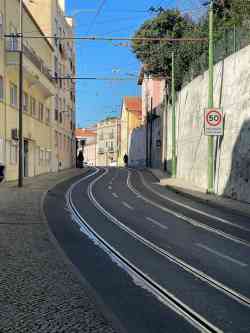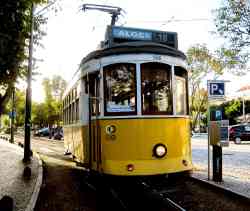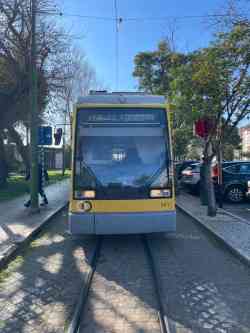Хронология
| 31.05.2015 |
Last day of operation for SATU. |
| 2014 |
Due to Portuguese laws that prohibit municipal assets to operate at a loss for three consecutive years, a decision has been made to close the operating line and to cancel the whole project. |
| 07.06.2004 |
Line is opened. |
| 2002 |
Construction of the initial route (Navegantes ⇄ Forum) begins. |
| Бүкіл хронологияны қарау |
Көлік құралын жылдам іздеу
Маршрут бойынша фотосуреттерді іздеу
Трамвай кәсіпорындары
АТН қызмет көрсететін кәсіпорындар
Электр автобустары кәсіпорындары
| • |
Viação Alvorada, Lda. · Carris Metropolitana
Established on 13.10.2020, and integrated into the Carris Metropolitana network as of 01.04.2022.
 | | 
The operator of both regular and electric buses serves the municipalities of Amadora, Cascais, Oeiras, and Sintra, while also offering routes to Lisbon.
Since April 2022, it has held the concession rights to operate within the Carris Metropolitana network for these municipalities, covering area 1 of the network and managing the lines designated as 1xxx. |
Модельдер тізімі
Суретке түсірілмейтін КС |
Maps
City Photo Galleries
Overviews
Ақпарат
|
Information about municipality
|
|---|


|
Oeiras
Founded: 1759
Area: 45,88km2
Population: 171`767
Oeiras is a coastal municipality situated in the Lisbon District, just to the west of Lisbon along the northern shore of the Tagus River (Rio Tejo). It is a part of the Lisbon Metropolitan Area and is recognized for its excellent quality of life, economic dynamism, and picturesque waterfront. Oeiras boasts a rich history of administrative importance and was among the first urban areas to develop alongside Lisbon’s growth. Currently, it serves a pivotal role in the metropolitan area, accommodating numerous multinational corporations, science parks, and research institutions, especially in the technology and pharmaceutical industries.
Oeiras enjoys excellent public transportation options, making travel easy both within the municipality and to Lisbon and Cascais: the Cascais line of the Lisbon suburban rail network, the Carris and Carris Metropolitana bus services, and Lisbon's tram network, which extends into the municipality for approximately 500 meters. However, in the 1950s, around 3.5 kilometers of the tram network were operational within Oeiras, and nearly 2 kilometers of the now-abandoned tracks remain visible in the streets. The remnants of SATU, a 1 km long fully automated people mover, are still visible a decade after the line was closed.
Oeiras is administratively organized into civil parishes: Algés, Linda-a-Velha e Cruz Quebrada-Dafundo, Barcarena, Carnaxide e Queijas, Oeiras e São Julião da Barra, Paço de Arcos e Caxias, and Porto Salvo.
|
|
Tram
|
|---|

Carris
(Companhia Carris de Ferro de Lisboa, E.M., S.A.)
Founded September 18, 1872
www.carris.pt
|
The municipality of Oeiras has experienced a decline in Lisbon's tram network since the 1950s. At its height, approximately 3.5 km of the network was located within Oeiras, beginning at Alges and traversing through Dafundo, Cruz Quebrada, and concluding near the national stadium (Estádio Nacional). Initially, the network was truncated to Cruz Quebrada at the end of the 1950s, and the segment to Alges was closed in the late 1990s, leaving only a 500m stretch with two stops remaining in Oeiras.
Visible remnants of the abandoned tracks between Alges and Cruz Quebrada can still be seen on the streets, and they are preserved even during road construction. Similar to other disused tracks in Lisbon, these tracks are no longer physically linked to the operational network due to the removal of switches. However, this particular section of Lisbon's tram network is unique as it retains its catenary.
Despite the track's preserved condition, there are currently no official plans to reopen this segment of the network.
|
|
AGT
|
|---|

Sistema Automático de Transporte Urbano
Founded 2004
Disolved 2015
|
System data
Length: 1,15km (built) / 11,63km (planned)
Number of stations: 3 (built) / 16 (planned)
The system employed a MiniMetro automated people mover on an elevated track (gauge unknown). The rolling stock consisted of two non-motorized cars, each capable of carrying 106 passengers. These cars were moved by a cable system powered by an electric motor located at Navegantes Station, similar to a cable tram on a guided track. The line featured a single track that branched into two at the stations. SATU ran at four-minute intervals during peak hours, but also functioned as an on-demand service during periods of low ridership. At these times, passengers could request a SATU car by pressing a button at the station.
History
The Sistema Automático de Transporte Urbano, commonly referred to as SATU, was an initiative aimed at establishing rapid transit between Paço do Arcos, a station on the Cascais railway line, and Cacém, a station on the Sintra railway line, with an additional branch extending to the São Marcos neighborhood. The proposed total length of the system was nearly 12 kilometers, featuring 16 stations.
Construction commenced in 2002, with the first phase completed in 2004. Services began on 7th June 2004, operating between Navegantes, located next to the Paço do Arcos railway station, and Forum, which is adjacent to the Oeiras Parque shopping center. However, this initial segment was only 1.15 kilometers long and included just three stations.
The second phase, intended to connect Forum to Lagos, was scheduled to begin operations in 2005 but was never realized.
In 2014, due to Portuguese regulations that prevent municipal assets from operating at a loss for three consecutive years (with Oeiras municipality holding a 51% stake), a decision was made to shut down the system. The final day of service was 31st May 2015.
In 2017, during the re-election campaign of Mayor Isaltino Morais, who had inaugurated the system in 2004, there were promises to reopen and even expand the system (it remains unclear whether this would follow the original plan or a new one). Despite Morais winning the election, the system has yet to resume operations.
Even a decade after its closure, the system's infrastructure remains intact, yet access to the stations is limited. In early 2025, however, a bold proposal emerged to transform the existing infrastructure into a BRT system and expand it. This announcement, though, seems to have been more of a political maneuver than a genuine initiative, as the promotional materials featured solely an electric bus from the Metro Mondega in Coimbra placed on the SATU infrastructure.
|
|
Electric buses
|
|---|

Carris Metropolitana
Founded April 1st, 2022
www.carrismetropolitana.pt

Viação Alvorada
Founded October 13th, 2020
|
The Carris Metropolitana network offers bus services throughout the Lisbon metropolitan area, featuring routes that operate within individual municipalities, connect neighbouring municipalities, or provide direct access to Lisbon.
The metropolitan area is divided into four zones, with Lisbon at the center, and each of the four licensed operators managing their respective areas while facilitating seamless travel across zones. These operators have assumed control of nearly all local routes established before 2022, ensuring a consistent level of service across the entire metropolitan region. Barreiro and Cascais are the only two municipalities that have maintained their own bus operators independent of the Carris Metropolitana network; however, by 2025, they do not operate electric buses.
Each route number in the Carris Metropolitana network consists of four digits, where the first two digits indicate the route's location. The first digit represents the network area (1, 2, 3, or 4), while the second digit denotes the route type (0, 1, 2, 3, or 4 for routes within a single municipality with each number indicating which municipality from this area; 5 for inter-municipal connections; 6 for routes linking Barreiro and Cascais; 7 and 8 for routes connecting to Lisbon; and 9 for routes extending beyond the Lisbon metropolitan area). The last two digits simply represent the route number, which may sometimes correspond to a local route established before 2022.
Oeiras, located in area 1 of the network, is served by Viação Alvorada from Oeiras, which operates routes 11xx within the Oeiras municipality, 15xx connections to adjacent municipalities excluding Cascais, 16xx connections to Cascais and area 2, and 17xx direct routes to Lisbon. There are no dedicated electric bus routes; all routes can be serviced by either regular or electric buses.
|
|
|
Кездейсоқ фотосурет

     
|
 Қалалық электр көлігі
Қалалық электр көлігі






























 |
| 




